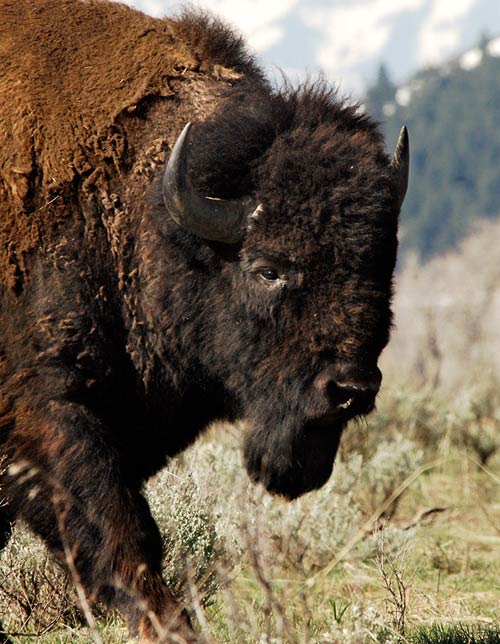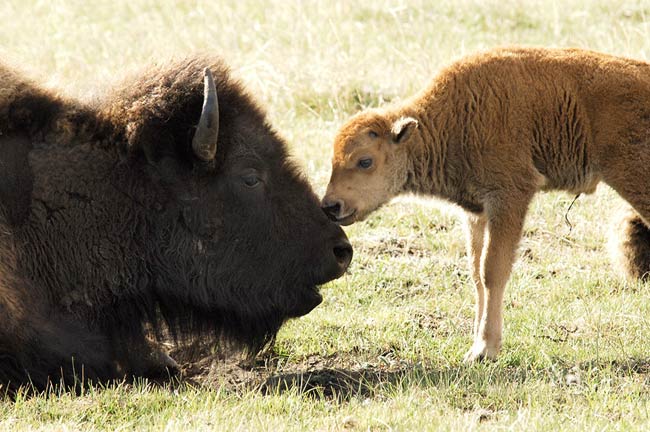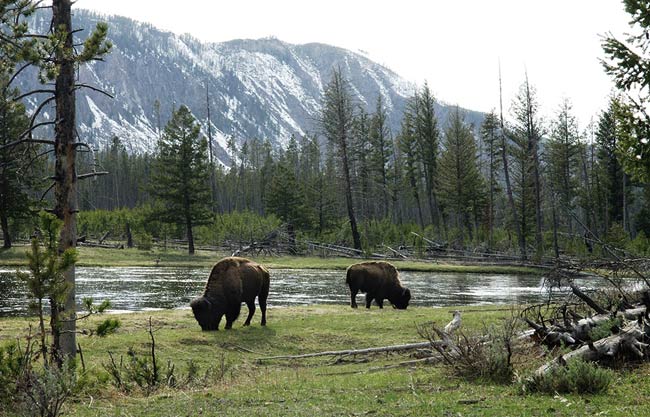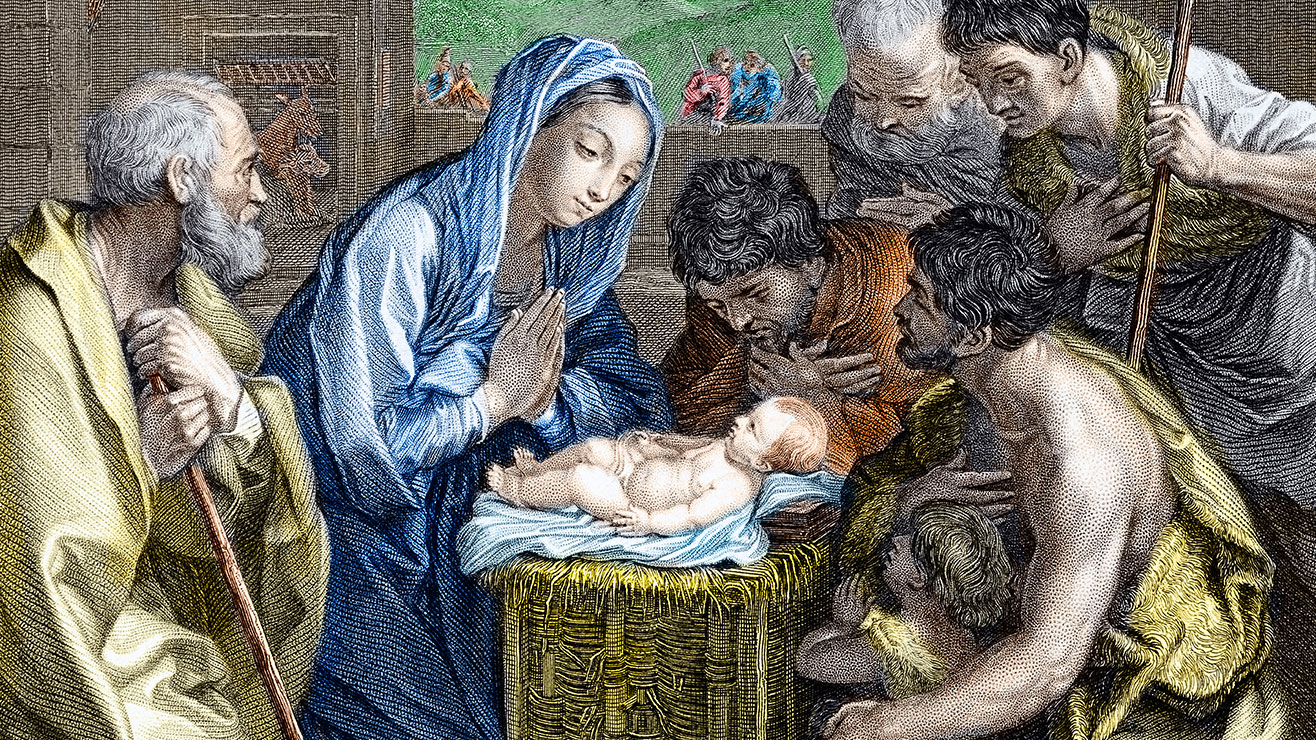Bringing Back Bison: Returning an American Icon to the Wild


Just because bison are big hasn't saved them from getting pushed around — the iconic American animal's dramatic scrape with extinction is a familiar tale of the American West and its settlement. Today, most of the herd is penned in, but a group of supporters are aiming to revive the wild population.
In the 17th century, the bison was the most abundant large mammal in North America. Estimates of their former populations on the Great Plains range from 30 million to 60 million individuals. People once told of herds so large it took days for them to pass by. Yet by the early 20th century, after years of indiscriminate slaughter for their valuable hides and bones, only about 1,000 bison existed on Earth.
"And fewer than 200 of those were in the wild," said Kent Redford, director of the Wildlife Conservation Society Institute and a leader at the American Bison Society (ABS).
Thanks to action by a few private individuals and some government protection, the few animals that survived have given rise to the 400,000 or 500,000 bison alive today. [Related: Ten Species Success Stories.]
However, despite their starring role in what Redford calls "one of the most successful conservation stories in this country," Redford says the massive beasts still need a champion.
This week, dozens of such bison champions can be found at a nondescript Marriott hotel in Tulsa, Okla. There, amid a sprawl of parking lots and mid-rise office buildings, where the only thing that calls to mind the majesty of nature is the names of the conference rooms (Silver Oak, Sequoia), the ABS will attempt to help determine the fate of wild bison.
The organization is holding its third meeting since Redford, at the behest of the Wildlife Conservation Society, revived the ABS in 2005, a century after the group was founded by Teddy Roosevelt and William Hornaday at the Bronx Zoo in New York City.
Get the world’s most fascinating discoveries delivered straight to your inbox.
Private vs. public
Up to 95 percent of bison alive today are in private hands being raised for meat, Redford said, and members of the ABS would like to see those percentages shift.
"We're not against commercial production of bison, but we created a community that is interested in re-establishing bison as ecological actors on the stage of North American grasslands," Redford told OurAmazingPlanet.
Basically, Redford said, bison that are not raised for sale, but are left on their own in nature.
This goal is of mutual interest to the seemingly strange bedfellows that belong to the ABS — conservationists, bison ranchers, scientists, government representatives and American Indian tribal leaders.
"We all love bison, and we're all in favor of increasing the bison in the herds across the country," said Dave Carter, head of the National Bison Association, an industry group for private bison ranchers.
Carter acknowledged that although some in the private ranching community look askance at efforts to team up with conservationists, he said increasing so-called "conservation herds" on public lands is in everybody's best interest.
In the United States today, there are roughly a dozen such conservation herds, managed for the most part by the Department of the Interior, of about 20,000 animals in total.
There have been efforts to list the bison as an endangered species, but in February, the U.S. Fish and Wildlife service, after a lengthy review process, declined to do so.
"One of the justifications to deny that petition is that the conservation herds in the U.S. are stable or increasing," Carter said. "So if we can help those herds grow we see that as a good thing."
Champion of the grasslands
For people like Redford, returning bison to the United States' open grasslands is just one large piece of an even larger conservation puzzle.
"If bison were managed with fire in large enough areas, it is our belief that there would be the restoration of many other species and ecological processes that used to typify the grasslands of the United States," Redford said.
Where bison roam, Redford explained, soon follow a host of other species that formerly lived on the prairie, from plants to birds to wolves — even grizzly bears.
"Our association of grizzlies and wolves with mountains isn't because they prefer mountains, but because that's the only place they were allowed to survive," Redford said.
Muddy genes
Redford said the ABS is facing three main challenges. First, bison occupy a murky status according to state and federal laws — as livestock and wildlife — and Redford said their legal standing needs to be clarified.
Second, is the challenge of brucellosis (B. abortus), a bacterial disease with a nasty name and effect that originated in cattle, and made the rounds to other ungulates like bison and elk. The disease is largely controlled, but some livestock producers fear infection from wild bison, a claim that lacks solid evidence.
Finally, there is the matter of bison genetics.
The latter issue is a big focus of this year's meeting. Most bison, it turns out, are genetically mixed: mostly bison, but with a little bit of cow lurking around the genome.
Back when bison were nearly exterminated, in the 1890s and 1900s, a few creative ranchers got the idea to breed them with cattle. Bison are extremely hardy, and the idea was to create a kind of super-hybrid that could survive temperature extremes and diseases, a quality that would make the animals extremely profitable.
The practice was quickly abandoned — "You get a female cow with a bad attitude and a bull that is sterile," Carter said — yet since today's bison all come from such a few animals, those cattle genes have stayed in the mix.
In addition, technology doesn't allow for efficient testing of animals. When looking at bison DNA, scientists only look at a certain strip of the animal's long genetic code, and it could be that cattle genes are hiding out in another, unexamined region of the genome.
The only genetically "pure" bison left are the roughly 3,000 animals that live in Yellowstone National Park.
Some argue that only the "purest" bison should be put in conservation herds. It is a confounding problem, given the difficulty of determining a given animal's "bison-ness."
Redford says that, although retaining the best genetic representation is important, the issue shouldn't halt moves to increase conservation herds.
Pointing to the recent discovery that Neanderthal genes lurk in our own genome, Redford said, "It happened a long time ago in human genetic history, and we don't understand ourselves as any less human."
In addition to the practical benefits wild bison offer, Redford said that in the end, the iconic species offers something less tangible yet equally important — especially given the animal's near disappearance and dramatic rescue, it has always loomed large in the American consciousness.
"When people are given the chance to see wild bison," Redford said, "they find a way to connect to the natural world."
And perhaps to each other. "Nobody texts when they're in the company of wild bison," Redford said.
Andrea Mustain is a staff writer for OurAmazingPlanet, a sister site to LiveScience. Reach her at amustain@techmedianetwork.com. Follow her on Twitter @AndreaMustain.




